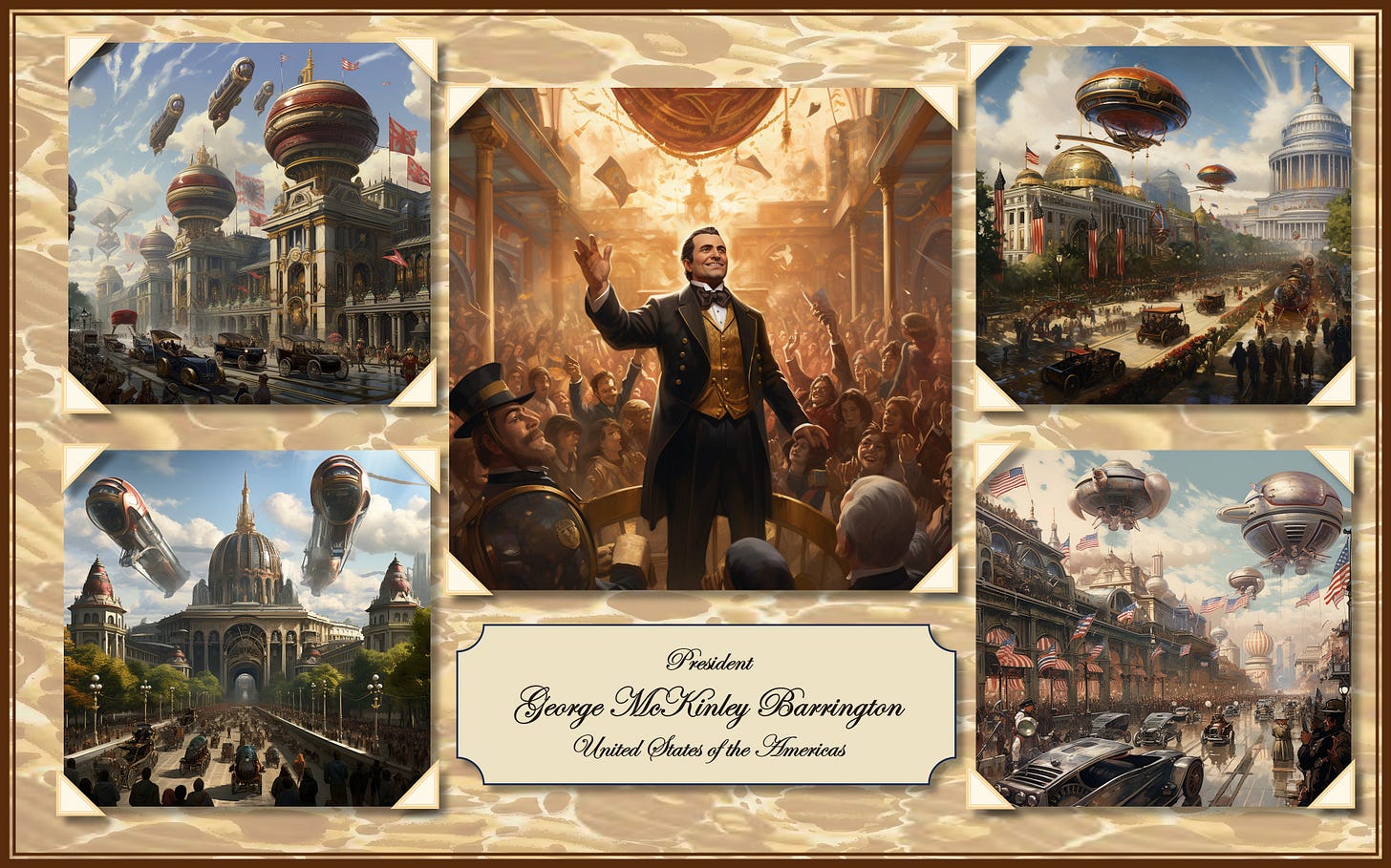
Paid subscriptions help keep Bastiat’s Window going. Free subscriptions are deeply appreciated, too. If you enjoy this piece, please click “share” and pass it along to friends, family, and colleagues.
The Official Souvenir Program distributed at William McKinley’s second inauguration in 1901 offered a peculiar work of whimsy—a 1,500-word description of inauguration of one “George McKinley Barrington” as President of the United States of the Americas—in 2001. Reproduced below in its entirety, this fantasy was a blend of science fiction and colonialist utopianism. It offers a snapshot of what late Victorian Era Americans presumed would be the aspirations and ideals of their great-grandchildren a century hence. For me, it also offers a cautionary tale for 2023’s “longtermism”—an ethical movement which holds that “positively influencing the longterm future is a key moral priority of our time” or, for some longtermists, the moral priority of our time.
Last week, the Persuasion substack offered two competing takes on longtermism, both tethered to its twin philosophy, effective altruism (EA). Both writers favor EA, but while Matt Lutz argued for longtermism, Brian Lui disagreed, arguing that longtermism “is impractical and does more harm than good.”
A few weeks back, I described the essence of EA and both my appreciation for and concerns about the movement:
“Ostensibly, the idea is to think systematically about charity, to develop metrics concerning the relative effectiveness of different charitable outlets, and to use those metrics to apply cost-effectiveness analysis to help allocate resources across charitable institutions. Both the goal and the mathematical approach of EA appeal to me as an economist, but I’m always aware of economists’ chronic overconfidence in the ability of mathematical tools, created and operated by a clerisy of ‘experts,’ to optimize over complex human behavior.”
In a Substack Note referring to Lutz’s, I offered more specific concerns:
“(1) EA calculators are no more reliable/objective than are central planners; (2) authoritarian EA ([Matt Lutz]: ‘Some people sincerely think that you’re morally obligated to work in finance to donate all of your money to research that prevents a rogue AI from destroying humanity.’) is dangerous and prone to crowd out reasonable voices; (3) EA is loaded with political activists like [Sam Bankman-Fried] who would harness police/taxation powers of the state to implement their ideals; (4) There is virtue in the messy process of humble individuals thinking about charity and making idiosyncratic choices.”
Longtermism extends these problems across an intertemporal dimension. Whereas EA expects enlightened experts to instruct others how to rationally allocate resources across earth’s present-day inhabitants, longtermists want to effecively reallocate resources from those same present-day inhabitants to those who won’t be born for centuries to come. Sigal Samuel at Vox described the idea as:
“In a nutshell, longtermists argue that future people matter morally just as much as people alive today; that there may well be more people alive in the future than there are in the present or have been in the past; and that we can positively affect future peoples’ lives.”
By all means, to the best of our abilities, we should contemplate the long-term implications of what we do. John F. Kennedy quoted an intuitively appealing parable attributed to France’s Marshal Hubert Lyautey, who purportedly asked hs gardner to plant a tree. In Kennedy’s telling:
“The gardener objected that the tree was slow-growing and would not reach maturity for a hundred years. The Marshal replied, ‘In that case, there is no time to lose, plant it this afternoon.’”
Ronald Reagan expressed a similar sentiment in his First Inaugural Address.
“On the eve of our struggle for independence a man who might have been one of the greatest among the Founding Fathers, Dr. Joseph Warren, president of the Massachusetts Congress, said to his fellow Americans, ‘Our country is in danger, but not to be despaired of . . . . On you depend the fortunes of America. You are to decide the important questions upon which rests the happiness and the liberty of millions yet unborn. Act worthy of yourselves.’”
All of this said, it is equally important remember the debilitating constraints that limit our practical capacity to conduct rational longtermism:
A Danish aphorism, holds that, “It is difficult to make predictions, especially about the future.” (Many attribute some variant of the phrase to Yogi Berra but, as he actually seems to have said, “I really didn’t say everything I said.”) John Maynard Keynes famously made a much safer prediction about the future: “In the long run, we are all dead.” In the President Barrington fantasy, the 2001 inaugural parade is a spectacle of flying cars or, more specifically, “aerialautos,” “aeroplanes,” “aerialtrans,” and “other conveyances,” including “pneumatic drags.”
We are perhaps even poorer at anticipating the consequences of our own actions over the long-term. One can argue that longtermism was the watchword of the day in McKinley’s time—notably in the guise of eugenics. Scientists, public figures, and the general public clung to the notion that careful, scientific pruning of mankind’s family tree would lead to a superior race and a brighter future—with bold predictions of money saved from eradicating whole classes of criminals, misfits, and the disabled. The result was a barbaraic optimism that ultimately yielded nothing more than wholesale violation of human rights.
Longtermism can ignore the fact that our progeny may disagree vehemently with what we perceive to be a better, brighter future. Aside from breathless science fiction, the Barrington piece is also in part late-Victorian Era colonialist fantasy, describing a wildly upbeat United States that somehow has absorbed the entire Western Hemisphere, along with a vast list of territories, unnamed, save for the Philippines. Two years before the inauguration, Rudyard Kipling paid homage to McKinley’s successful prosecution of the Spanish-American War and, in particular, America’s actual conquest of the Philippines. That poem, “The White Man’s Burden” can be read as an examplar of longtermism circa 1899—one whose goals are not widely shared today.
Brian Lui’s essay covers these points far more thoroughly than I do here. For a few of his quotes:
“[I]t’s not obvious that people living today have the same moral obligations to future generations as we do to our own.”
“[T]he world is so full of randomness and chaos that it’s impossible to predict how an action taken today will affect people hundreds or thousands of years from now.”
“[A]ttempts to address problems often backfire.”
“[A] big problem with longtermism is that it crowds out other charitable efforts.”
I can quibble with points made by Lutz and Lui, but I’ll recommend both as worthy readings on EA and longtermism. Now, on to President Barrington’s inaugural!!!
President George McKinley Barrington
The Inauguration in the Year 2001
The following text comes from the Official Souvenir Program distributed at the inauguration of William McKinley and Theodore Roosevelt, March 4, 1901. Illustrations produced by Robert Graboyes © 2023 at Midjourney.com.
“George McKinley Barrington, of the State of Ontario, was today at high noon invested with the office of President of the United States of the Americas. The ceremonies attending the inauguration were the most elaborate in the history of this country, and were made the more significant as being the first ceremony of the kind in the Twenty-first Century. Not less than $10,000,000 was expended on the celebration, and more than 10,000,000 people witnessed and participated in the exercises. President Barrington is the tenth Chief Magistrate to be elected to the new term of eight years, and he was accorded such a reception as has never before been witnessed in this city.
The inaugural parade was thirty-six miles in length, and despite the fact that those participating were carried in aeroplanes, aerialautos, and other conveyances from the Mansion of Executives to the Capitol, the line occupied more than three hours in passing the State aerialtrans, and slightly delayed the programme as originally proposed. The State aerialtrans left the Mansion of Executives at 9 o'clock, and was stationed at the head of the Avenue of the Americas, down which, at an altitude of about 300 feet from the pavement, the parade approached. With President Barrington in the airship were Vice President Harris, ex-President Brown, and ex-Vice President Thompson, the members of the going Cabinet, the Speaker of the House of Representatives, the President of the Chamber of Territories, and a number of other Government officials. Mr. Sterling, Secretary of State for the Philippines, was unable to attend, owing to a severe hurricane on the Pacific, which blew his aerialtrans from its course and compelled him to make the trip via Cape Horn with great delay.
Every city in the Union was represented in the parade by one or more conveyances, and the decorations were unique and beautiful. Among the finer displays were those of clubs from Sitka, Santiago de Chile, Montreal, Rio de Janeiro, Mexico City, Havana, Manila, Honolulu, Quebec, St. Thomas, Chicago, and New York.
Detachments from forts all over the country occupied the war machines, which made a brilliant spectacle as they swept past the reviewing air ship. The new 30-inch gun was in evidence on many of the war machines, and during a drill later in the day a shell was thrown into the Chesapeake bay, outside Baltimore.
At the new Capitol the scene was one of activity. From early in the morning until the noon hour the crowds had accumulated until nearly a half million people had been packed into the great glass-covered arena which fronts the east facade of the new Capitol building. From the Department of Transportation on the right to the Department of the Press on the left was a solid line of spectators which taxed the enormous Crystal Auditorium to its utmost capacity. Four great automatic bands were placed in the corners of the space and, operated by buttons, simultaneously rendered a programme of popular music.
The route of the parade compelled the line to turn at the Department of Oil Lands, and, after cutting across Hanna Avenue, proceeded down the Avenue of the States to the State aerialtrans. Then, headed by the President's conveyance, the line returned over the Avenue of the States to the Capitol. As the President passed over each of the State arches he was saluted by a volley of electrical bombs, the number of shots designating the order in which each State was admitted into the Union. The appearance of the President was the signal for a great demonstration on the part of the spectators who crowded the route in airships, and watched the line from the gardens on the roofs of the buildings along the Avenue of the Americas and the Avenue of the States. The ceremony passed off without a single mishap, and Grand Marshal Burns and his staff of 1,000 aides are to be commended for keeping the atmosphere between the avenues clear of conveyances. The police and medical aeroplanes were ever in evidence, and the corps performed efficient work.
On reaching the Capitol the President and his party landed at the public station on top of the dome and proceeded in elevators to the State wing, where the new official was formally greeted by the members of the Senate, House of Representatives, and Chamber of Territories. It was a distinguished throng— the forty members of the passing Cabinet, the Supreme and Vice Supreme Courts, the 336 Senators, 860 Representatives, 99 Territorial Delegates and scores of statesmen, and Army and Navy officials being present. Secretary Garner, of the Department of Telegraphs and Cables, was the first to greet Mr. Barrington, and presented him with sympthacables from the Congress of the British Republic; President Guerland, of the United States of Germany; King Louis XXI, of France; President Arcolie, of the Republic of Italy; and President Cinerot of the Republic of Spain and Portugal. No word was received from Russia, owing to the recent death of the Czar.
Escorted by hundreds of statesmen, the new and the old Presidents made their way to the platform facing the Crystal Auditorium. The four great mechanical bands struck up the national anthem and the vast gathering cheered itself hoarse. As the candidate of the American party and the choice of all three Houses of Congress, Mr. Barrington is very popular, and received a royal ovation. After taking the oath of office the new President delivered his inaugural address, which will be found on another page. His speech was remarkable for its brevity, and yet for the numerous recommendations made. Among these is the suggestion that the work of turning the Arctic current aside, off the coast of Labrador, so as to enable the Gulf Stream to change the climate, be begun at once, and that the anti-trust law prohibiting any corporation from making profits in excess of six per cent, per year, be strictly enforced.
At the close of his address. President Barrington was escorted to the Mansion of the States by the Governors of the 118 States and 99 Territories. Here a great banquet was spread in the main hall, covers being laid for 25,000 persons. All of the Government officials and the heads of the Army and Navy were present, and many notable addresses were delivered through the phonelegraph.
Late in the afternoon a carnival was held on the lower pavement of the Avenue of the Americas. The spectators were arranged on the upper malleable glass pavement and in the lower floors of the buildings along the thoroughfare. The glass canopy over the Avenue was handsomely decorated with silken streamers, while the flags of all the Republics were plentifully distributed.
The programme included a parade of the President's Guard (foot) and the crews of the naval submarine and aerial vessels Hector, Dewey, Schley, Sampson, Buenos Ayres and Holland. The evolution of the aerial forces with the new meteorite guns were deservedly applauded, and the great tubes were raised and lowered by the operation of the gas in the jackets. The Pneumatic street railway lines were stopped on all surface tracks and the avenues kept clear.
Later, at 16 o'clock, and lasting until 18 o'clock, an “Old Century” parade was made the feature, and created much merriment. In the grotesque line were ancient vehicles known as “automobiles,” “locomobiles” and “glides.” Other features were “bicycles” from the Museum of the Americas, and an electric street car from the New York State Museum. Ancient steam engines found in the States of Manitoba and Asssiniboia were conveyed on pneumatic drags.
To-night the Inaugural concert and ball is in progress in the Park of the Presidents. The scene is a brilliant one, the acres of bright-colored glass canopy being reflected from above, by varicolored lipthalite lamps, on the tinted glass flooring. Twenty thousand couples participated in the programme of dances, and many distinguished foreigners who arrived late in the afternoon by private air yachts were present.
In the city the avenues were all beautifully illuminated by means of lipthalite lights, which shone through the glass sides of buildings and residences, and caused diamond rays to form in the center of the thoroughfares. A night parade of aerialtrans and other conveyances was another feature, all of the vessels being illuminated and making a wonderful spectacle. The programme for to-morrow includes a parade of National Militia, 100,000 strong, and submarine vessel war tactics in the Potomac river. The celebration will continue until March 8, when the President will be formally installed by Congress.
Hundreds of thousands of people continue to pour into the city. The Southern, Northern, Central and Trans-Pneumatic railways are operating more than one hundred trains per hour from San Francisco, Vancouver, Rio, and other main junctions, while the aerial transcontinental lines are taxed to their utmost capacity.
The Inaugural Committee is hard at work and accommodations are plentiful. The Great Central Hotel alone had 19,000 rooms reserved and ready this morning, and the other public quarters are well filled. All in all, the celebration is worthy of the new century. and will make a striking comparison with the Inauguration of March 4, 1901, an account of which is reproduced elsewhere in this issue.”




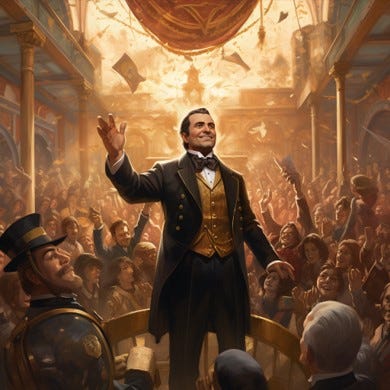
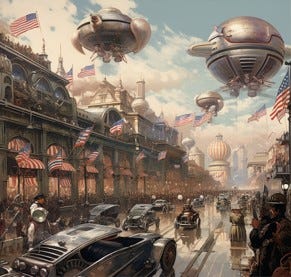
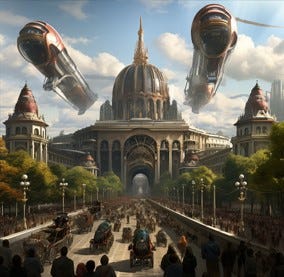
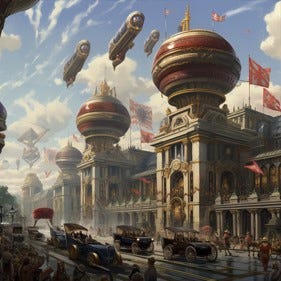
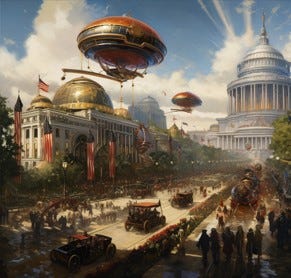
Thanks for a fascinating glimpse of our past and a discussion of the future through the lens of lontermism. Huge growth in government (and an Executive with a 1000 person staff!j at the dawn of the 20th century seems to foretell the coming Progressive wave and a prosperous future with great public works. As always, real Ilfe turns out a bit differently.
In 1893, eight years before the McKinley inauguration, Chicago hosted the World's Columbian Exposition. The Chicago Tribune commissioned essays from a variety of noted personalities to predict the state of the world in 1993. In that latter year, the Chicago Historical Society reprinted the essays in a slim volume called "Today Then," sadly now out-of-print.
A great many of the essayists expressed the same boosterism as the McKinley campaign: the United States encompassing the entire Western Hemisphere, Chicago the largest city in the world with a population of 10 million, etc. Many predicted air travel, television, talking pictures, and other technological marvels.
Not one predicted the automobile.
A great deal of ink was spilled describing how Chicago, with its 10 million residents, would handle the daily manure from the millions of horses necessary to run such a city.
The other major concern of the day was "the servant problem." This was noted many times, but never explained: it was just assumed that everybody knew what it was. It took me many years (1993 being pre-Google) to find out: this was rich people complaining that poor immigrant girls no longer wanted to be maids, since they could earn more money in a factory or sweat shop.